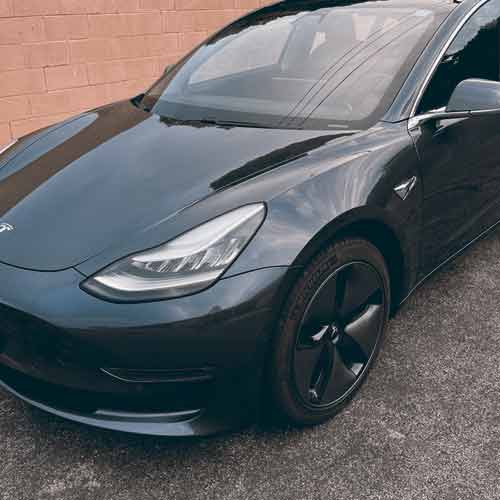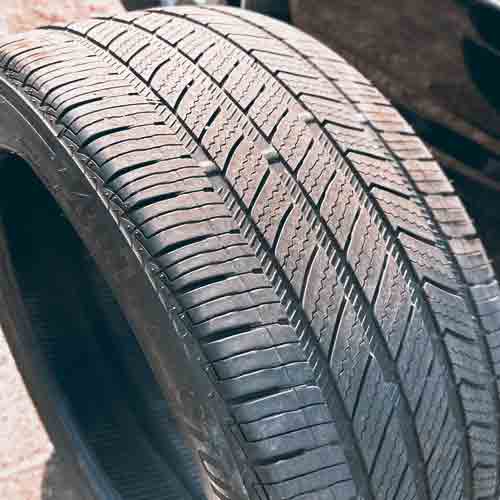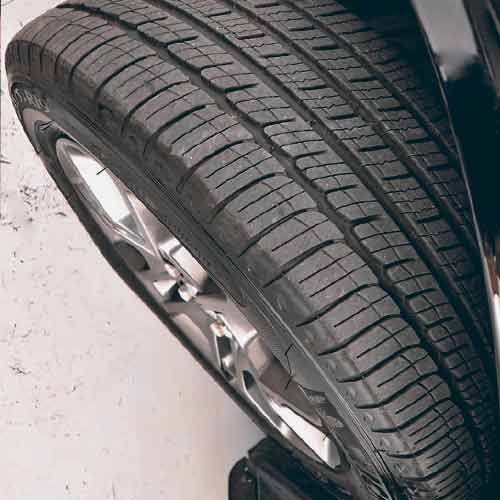When comparing the Bridgestone Turanza QuietTrack and the Michelin Primacy MXM4, it’s important to understand that both are classified as grand touring all-season tires. This category of tires is designed to provide a balance of comfort, durability, and all-weather traction, suitable for a wide range of driving conditions.

Key Points
So overall it comes down to this.
The Turanza QuietTrack excels in:
- Fuel Efficiency: Thanks to its stiffer compound.
- Winter Traction on Light Snow: With its heavier weight and smaller section width, in particular.
- Noise Reduction: Advanced technologies and materials reduce noise levels, making it quieter.
- Impact Comfort: Provides a smoother ride by absorbing road irregularities more effectively.
- Hydroplaning Resistance: Superior in displacing water at higher speeds.
Whereas the Primacy MXM4 takes the lead when it comes to:
- Overall Dry Performance: Its stickier rubber and denser shoulder lugs offer better cornering traction and handling.
- Wet Grip: Enhanced by a greater number and quality of sipes.
- Linear Grip: Thanks to its optimally designed contact patch and lighter construction.
- Lateral G-Forces during Turns: Exhibits superior performance in cornering due to its tread design.
- Wet Conditions: Its more biting and asymmetric tread pattern provides better wet traction.
Sizes and their Specs
The Bridgestone Turanza QuietTrack (review) comes in 15 to 20 inches wheels and they have the following specs.
- Speed ratings: H and V only.
- Load ratings: SL and XL.
- Tread depth: 9 to 10/32″.
- Weight range: 19 to 33 lbs.
- Treadwear warranty: 80k miles.
- UTQG rating: 800 A A.
On the other side, the Michelin Primary MXM4 comes with 43 total sizes in 17 to 20 inches, having following specs.
- Speed ratings: H, V, W and Y.
- Load ratings: SL and XL.
- Tread depth: 9.5 to 10/32″.
- Weight range: 21.5 to 30 lbs.
- Treadwear warranty: 50k miles for H and V speed ratings, and 45k for W and Y.
- UTQG rating: 500 AA A (some also have 420 A A).
Side Note: It’s crucial to distinguish between the MXM4 and the T1 variant. The T1 is uniquely endorsed by Tesla, indicated by the “T” for Tesla homologation, while the “1” signifies its status as the initial revision.
Fuel Efficiency
Tire fuel efficiency boils down to the resistance a tire faces when it rolls. And a lot of factors play into this: the tire’s weight, the materials used inside and out, and the type of rubber in the tread.
With these factors in mind, it can be seen why the Bridgestone Turanza edges out overall, providing relatively better mpg readings on my multiple tests.

Simply put this is largely due to its rubber composition, which is less sticky. I mean sure, this results in lesser grip, and its relatively lower speed rating values across all sizes, this is where it pays off, literally (in terms of fuel savings).
Furthermore, the tire’s stiffer compound plays a key role. It keeps rolling friction down, which not only enhances its fuel economy but also ranks it high in terms of tread longevity.
In fact, based on its performance, I’ve included the Bridgestone QuietTrack in my list of top grand touring tires, especially for its outstanding tread life. You can check out the full list here: https://tiredriver.com/best-grand-touring-all-season-tires/
Winter Traction
All-weather tires are generally a solid bet for winter conditions, providing superb steering, braking, and accelerating on different kinds of terrains (including light snow, ice or a mixture of both).
But since both tires here aren’t all weather, and only all season, you can’t expect too much out of them.
The difference: All season tires aren’t rated with 3 peak mountain snowflake certification unlike all-weather tires, making them unsuitable for severe snowy terrains.
Though my comparative testing show that overall, the Bridgestone QuietTrack offers better performance on light snow, while the Primacy MXM4 lead on icy terrains.
So, what’s the deal with that? Well the Michelin tire offers relatively softer rubber composition, and greater number of biters. So when the temperature drops (which is the case on icy tracks), the tire’s rubber adjust a little better thermally, providing superior traction.

Now, flip over to the Bridgestone’s tire. Despite having less aggressive notches and siping, it surprisingly does a better job on powdery/soft snow. And this is mainly because of its heavier weight and slightly slimmer profile (average section width) along with biters embedded on its grooves.
All of these design features basically help the tire press down harder on the snow, gripping and holding onto snow particles. This creates better snow-to-snow contact, which is key because snow sticks to snow better than it does to rubber.
Overall Dry Performance
Evaluating a tire’s overall dry performance, two things need to be looked at separately. Directional grip and overall handling.
Overall Handling
Dry handling is the combination of tire’s lateral grip and steering feedback.
When considering cornering traction, the Primacy MXM4 demonstrates superior performance, as indicated by its slightly higher lateral G-forces during turns. This advantage is largely attributed to its stickier rubber composition and denser shoulder lugs.
These shoulders or tread edges matter here the most, as they get the most concentrated weight on them, as the tire takes the turn. In other words they connect with the road more indicating their footprint significance.
Though major overall handling difference is still seen in terms of steering responsiveness of both tires, where Turanza QuietTrack struggles due to its less optimized contact patch, with greater tread flexibility.
These design elements basically causes its lugs (on the tread) to bend more (as the tire corners). Why is that important? Well this is because when lugs bend more, they take longer to get back to their original position/shape.
And that time is seen as the delay between steering inputs and outputs (from the wheels).
Though interestingly, the overall difference between the two tires here reduces significantly when XL sizes are compared (vs SL load rated ones).
Learn all about load ratings here.
Linear Grip
In the tire industry, “linear grip” refers to a tire’s ability to maintain traction in a straight line, primarily evaluated through its braking performance.
This grip primarily originates from the tire’s central tread area, where the weight distribution is concentrated when rolling straight.
In this context, the Michelin Primacy MXM4 stands out due to its optimally designed contact patch, which is further enhanced by strategically placed lateral biting elements to improve its stopping power.
Additionally, this tire benefits from a relatively lightweight construction, resulting in lower momentum inertia. This feature translates into more efficient braking performance.
On the other hand, the Bridgestone Turanza QuietTrack prioritizes longevity, thus compromising somewhat on grip as part of its strategy to reduce rolling resistance.
And yes, it’s designed with larger tread voids and a somewhat narrower section width. While these features are advantageous for winter conditions, providing better traction in snow, they result in less rubber making contact with the road during dry conditions, thereby diminishing grip.
Wet Performance
Wet performance is determined by both wet traction and resistance to hydroplaning. Let’s evaluate how well these two aspects were handled by both tires here.
Wet Grip
Wet traction involves efficiently removing water from the tread. This is essential because water is incompressible which means if it’s not quickly cleared, it can interfere with tire contact, leading to slipping or, in more severe cases, hydroplaning.
Now the primary role in water removal is played by the grooves (the main voids on the tread), which channel most of the water away.
However, some water often remains, sneaking under the lugs. And this is where sipes (tiny slits on the tread) play a vital role. They act like miniature vacuums, drawing up the residual moisture and ensuring the tire maintains proper contact with the road surface.
Now, this is where the Michelin Primacy MXM4 takes the upper hand. This superiority is attributed to both the quantity and quality of its sipes.
I mean it offers relatively greater number of sipes (which implies more effective water clearance). And with a mixture of linear and interlocking (wave-like) siping design, those slits don’t get stiffen up like they do on Bridgestone’s tire.
In other words, the Turanza QuietTrack’s sipes are more prone to stiffening during intense maneuvers. And this lack of flexibility is further contributed by its relatively harder rubber composition too.
Moreover, with a symmetric tread pattern it just doesn’t provide the bite, the asymmetric tread design of Michelin MXM4 does.
Hydroplaning Resistance
Hydroplaning is a dangerous phenomenon where a tire fails to displace enough water through its grooves swiftly, causing the tire to float on the water’s surface. This results in a complete loss of traction, or hydro/aquaplaning.
Now here, despite its shortcomings in wet grip, the Turanza QuietTrack has a marginal advantage overall, allowing for slightly higher float speeds compared to its counterparts (where its 1 mph greater on average).
This superior performance is attributed to the better inter-connectivity of its grooves.
Sure both tires here feature four circumferential grooves, the design of the Michelin tire does not connect these grooves laterally like they do on Bridgestone’s tire.
Though keep in mind, that this difference is mostly seen while comparing SL sizes, and in terms of XL, both tires actually offer similar float speeds. (Let’s just say, its mostly has to do with tire’s weight).
Overall Comfort
Driving comfort is influenced by two key factors: tread noise level and the tire’s ability to absorb road irregularities. Let’s take a look at both one by one.
Noise Reduction
Alright, let’s talk about noise first.
So when it comes to keeping things quiet, the “QuietTrack” really shines, which one can guess by its name too.
This is because the tires comes with a lot of complicated technologies here. But keeping things simple it’s actually about a special tread design that changes how air plays with the tire, cutting down on noise through some clever sound cancellation tricks.
Plus, they throw in some sound-absorbing materials to keep that in-groove resonance to a minimum.
Whereas the Michelin Primacy MXM4? Not so much. Its tread design tends to create a kind of echo chamber effect, where sound bounces around a lot more when air hits the tread walls.
This amps up the noise when you’re driving particularly at highway speeds.
Impact Comfort
Moving on to comfort, it’s all about how a tire deals with the bumps and grinds of the road. And here again the Michelin Primacy MXM4 needs some improvement in comparison.
So what makes it “bumpier”? Well it’s got a tougher structure. I mean there’s a harder nylon cap ply with a spirally wound design in its internal construction. And sure it provides the tire with “handling” stability, its really not good against softening road vibrations.
This especially goes for larger bumps (as my subjective testing reveals), where the tire hits its flexibility limit sooner, and those bumps get sent straight up into the cabin.
The Turanza QuietTrack does the opposite, providing a more flexible inner structure for the most part, with the combination of stiffer skin on top, delivering a more optimal balance between stability and cushioning of the road imperfections.
Wrapping Up
So which tire is better overall? Well its not really that simple as both of these boys shine in various performance aspects.
The Turanza, with its less sticky rubber composition and stiffer compound, offers superior fuel efficiency, enhanced tread longevity, but yes this also explains why its less capable in terms of traction particularly on dry surfaces.
Though it also lacks to Primacy when it comes to wet performance.
Speaking of which the Michelin MXM4 shines when it comes to dry , wet and icy surfaces providing superior steering responsiveness in particular.
Though the tire still falls short in hydroplaning resistance and overall comfort.
Basically, the Turanza outperforms in noise reduction and impact comfort, utilizing advanced technologies and sound-absorbing materials, whereas the Primacy MXM4’s harder structure results in a noisier, less comfortable ride.